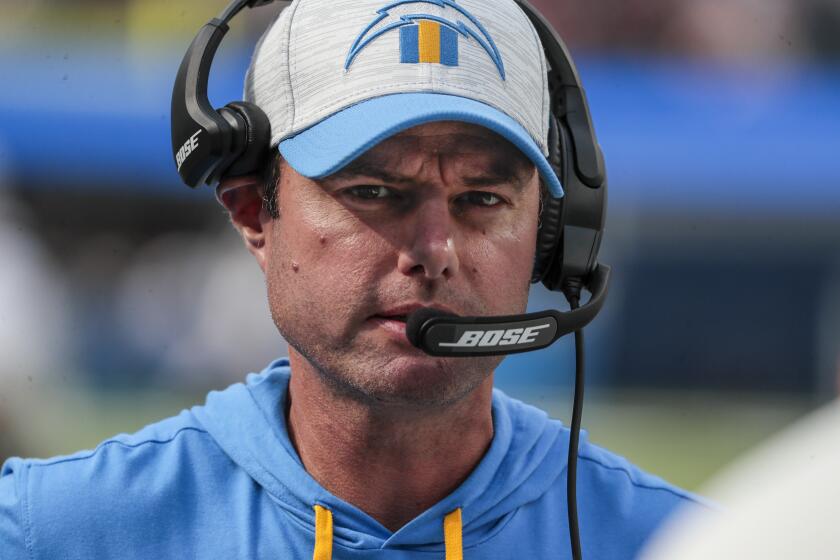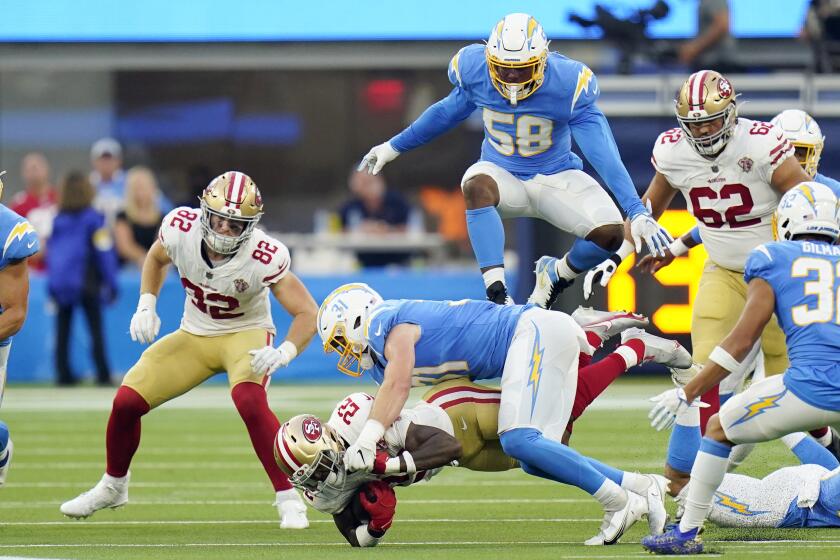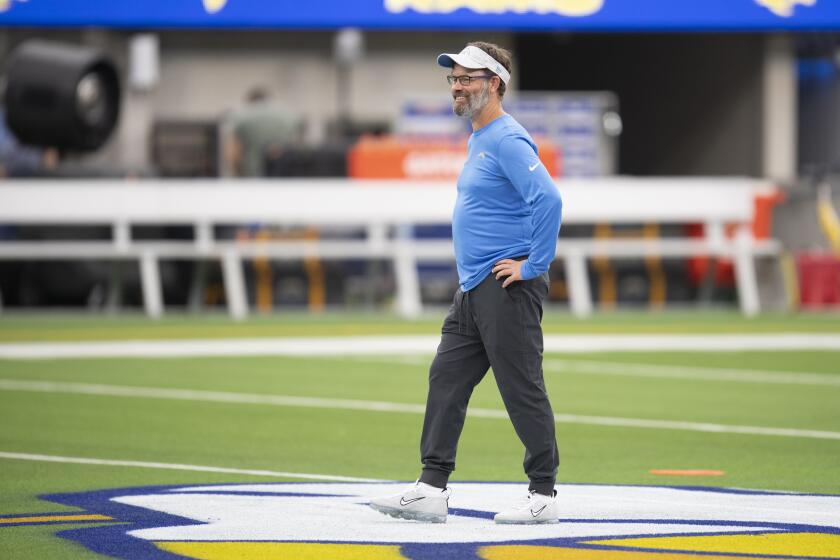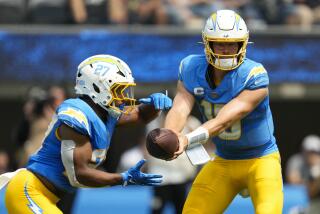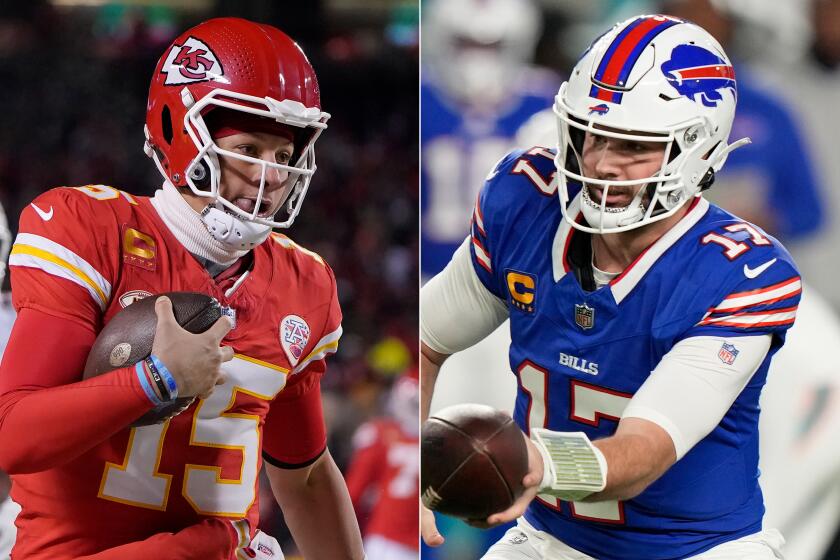A line can be drawn from Chargers’ prospects to the group in front of Justin Herbert
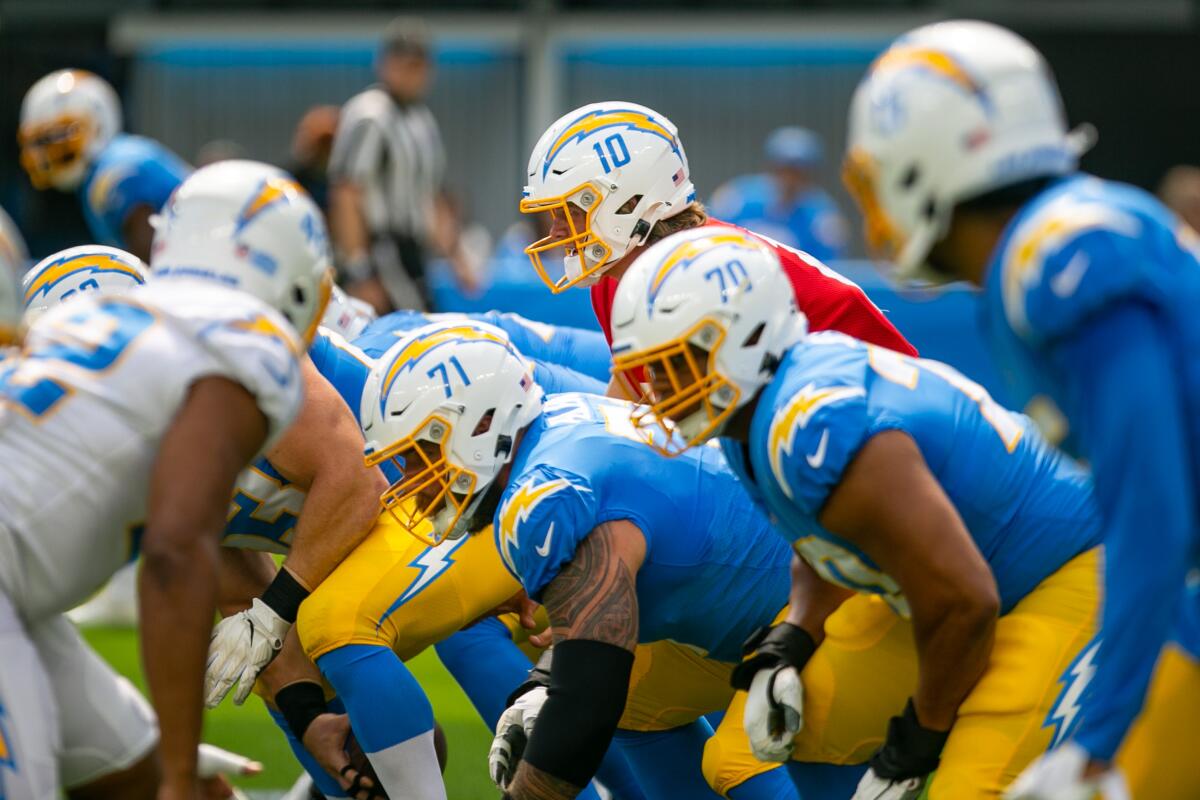
- Share via
The assignment was a familiar one, protecting the star quarterback a long-standing football tradition.
The payoff back then, however, was a little more quaint, the star quarterback treating his offensive linemen to the buffet at the local Cicis Pizza.
That was the reward for each week Frank Smith and his Miami of Ohio linemates kept Ben Roethlisberger from being sacked.
Smith has grown up to be the Chargers’ offensive line coach. And, while Roethlisberger still plays, Smith’s new assignment is to protect a different star quarterback — Justin Herbert.
“Back in the day with Ben, we saw in practice that this guy was capable of unbelievable things,” Smith said. “With Justin, our thing is to master our communication and do our job and he’ll be able do his at a high level again.”
The Chargers have their share of highlight-friendly playmakers. From Herbert to Keenan Allen to Joey Bosa to Derwin James Jr., they’re covered from sideline to sideline and front to back, on both sides of the ball.
New Chargers coach Brandon Staley isn’t afraid to talk about the franchise’s lack of success. And he’s prepared to change their fortunes.
Yet, this team’s fate in 2021 starts first where football always starts — up front on offense, in this case with center Corey Linsley and spreading in each direction. Offensive line play might not be sexy. But it is highly significant.
“If we do our jobs, it will allow the talent around us to shine,” Smith said. “We have to pave a way for the playmakers.”
Last season, the Chargers’ line struggled so much that four new starters were imported. Linsley and guards Matt Feiler and Oday Aboushi were signed in free agency and left tackle Rashawn Slater was drafted 13th overall.
The only holdover is right tackle Bryan Bulaga, and he was limited to less than 40% of the 2020 offensive snaps because of injury.
The offseason emphasis was on adding size and physicality in front of Herbert. Linsley is 6 feet 3, 301 pounds; Feiler 6-6, 330; Aboushi 6-5, 315; and Slater 6-4, 304.
“We’ve got size, but we’ve also got strong guys,” Smith said. “Sometimes, there isn’t a correlation in size and strength. We were looking for strong guys who could move and have that mass to really hold up in pass protection.”
The possibilities for the Chargers are indeed tantalizing. Herbert was the NFL offensive rookie of the year and a genuine revelation last season despite the team’s struggles to protect him.
His mobility and success under pressure helped lessen the impact of the line’s lingering issues. He repeatedly rose up — often looking in the direction of Allen — to overcome a blown assignment elsewhere.
When the Chargers line up, the defense led by head coach Brandon Staley appears the same every down. That’s the beauty of this multifaceted approach.
“From a talent standpoint, it would be almost impossible to find someone who has more,” said John Beck, a Huntington Beach-based quarterback coach who has worked with Herbert. “So it didn’t surprise me. But would I have said he was going to go out and win rookie of the year? There’s no way that I was anticipating that.”
With improvement in front of Herbert, who knows how much more he might do this season?
Linsley is the unquestioned leader of the group, Staley often referring to him as “a commander.” He was named an All-Pro in 2020 and, to land him, the Chargers made him the NFL’s highest-paid center at the time.
After spending the previous seven seasons with Aaron Rodgers, Linsley understands the importance of giving a star quarterback opportunity. He also understands Herbert isn’t the only one on offense carrying expectations.
“That’s the reason they brought us all in,” Linsley said. “There’s 100% pressure that we have to perform. Everybody across the league feels it. This is just our version of that pressure.”
While Linsley is the leader, Slater arrived as the prize. The fact he was still available at No. 13 was the break the Chargers had hoped to get.
Slater, who played at Northwestern, appeared for only one preseason series but dominated during a drive that lasted 21 plays. In practice, he also shined during drills before missing time because of a back issue that has since cleared up.
“He’s been everything that we thought he was going to be — explosive, strong, quick learner,” coach Brandon Staley said. “If there’s any issue, the next day, the next play he’s able to auto-correct.
With a new coaching staff comes a new offensive approach, but coaches know they still need Justin Herbert to make it all work.
“From what he has shown us so far, the growth is going to be pretty cool with him. He’s a really, really quick thinker. And he works at it as well as anyone I’ve been around.”
For the Chargers, everything along the offense line now has to jell as it never did a season ago. The first assignment is a thorny one, Washington featuring four first-round picks starting along its defensive front.
But who’s safely behind you becomes more important than who’s in front of you.
Smith was the left guard when he was blocking for Roethlisberger in college. In 2003, Miami finished 13-1 and beat Louisville in the GMAC Bowl, and Smith and his buddies ate a lot of Cicis Pizza.
The implications, especially with Herbert at quarterback, are a little higher now.
“Regardless of who’s back there, our job is to give that guy time to do what he needs to do,” Smith said. “The challenge that you face when the quarterback’s profile gets bigger is you want to take care of your job so that guy can star.”
More to Read
Go beyond the scoreboard
Get the latest on L.A.'s teams in the daily Sports Report newsletter.
You may occasionally receive promotional content from the Los Angeles Times.

